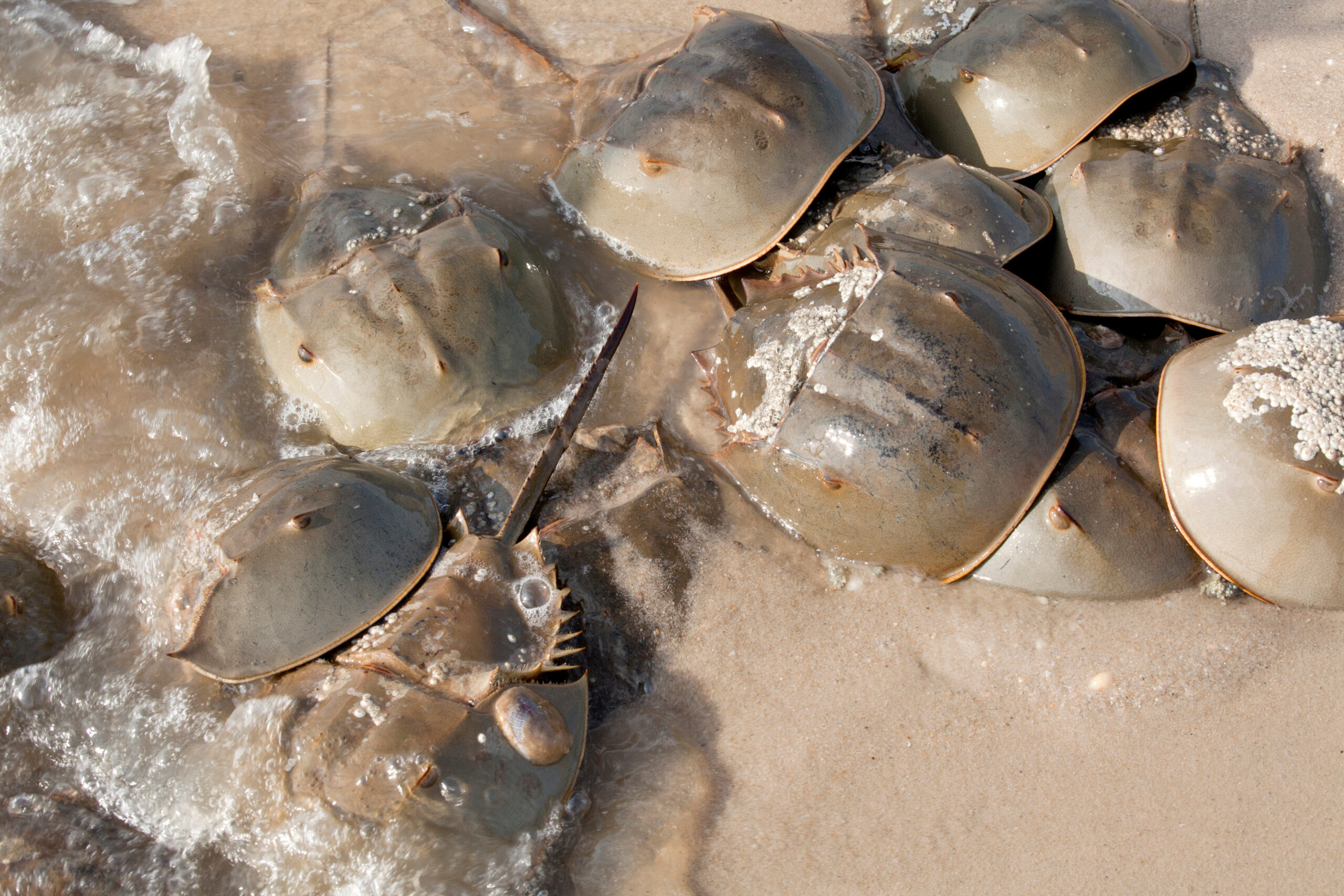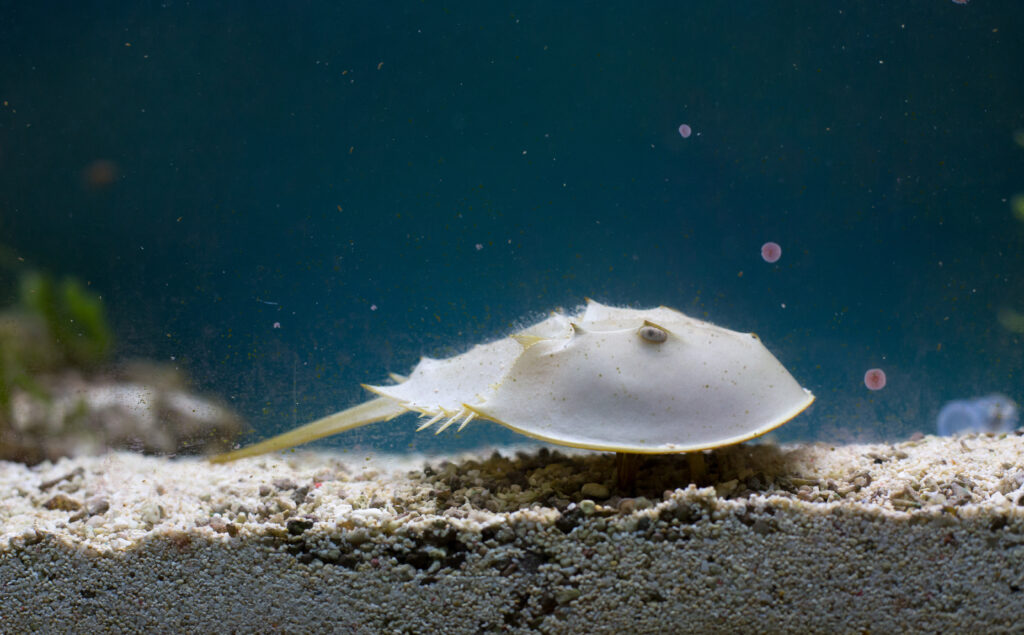
Blood Draw at the Horseshoe Corral
An essential medical safety test used around the world depends on horseshoe crab blood, and scientists may have discovered the key to a sustainable supply. Use the article from Coastwatch in your class.
North Carolina Standard Course of Study
8th grade science:
- 8.L.1.1 Summarize the basic characteristics of viruses, bacteria, fungi and parasites relating to the spread, treatment and prevention of disease.
- 8.L.2.1 Summarize aspects of biotechnology, including:
- Specific genetic information available
- Careers
- Economic benefits to North Carolina
- Ethical issues
- Implications for agriculture
Ocean Literacy Standards
- 1 The Earth has one big ocean with many features.
- 1.h Although the ocean is large, it is finite and resources are limited.
- 5 The ocean supports a great diversity of life and ecosystems.
- 6 The ocean and humans are inextricably interconnected.
- 6.b The ocean provides food, medicine, and mineral and energy resources. It supports jobs and national economies, serves as a highway for transportation of goods and people, and plays a role in national security.
Guiding Questions
Use the article, as well as the resources below, to respond to the following focus questions.
- What other organisms are closely related to horseshoe crabs?
- What ecological niche does the horseshoe crab fill?
- Describe the relationship between horseshoe crabs and red knots.
- Compare and contrast indoor and outdoor aquaculture of horseshoe crabs. Why did the researchers experiment with both systems?
- Why do you think that horseshoe crabs have evolved to lay thousands of eggs during a spawning session?
- Describe an adaptation that horseshoe crabs have that helps them survive in their environment.
- Discuss the pros and cons of biotechnology in today’s medical research.
Lesson Links and Resources
Atlantic States Marine Fisheries Commission – The mission of the ASMFC is to promote the better use of fisheries along the Atlantic seaboard. This federal agency manages over 25 commercially important species, including coastal sharks, fishes, and a few arthropods. The horseshoe crab is one of the agency’s managed species. At this website, discover life history information, stock status, and management plans, as well as landing data for both biomedical and bait use.
Ecological Research & Development Group – Learn more about the conservation issues surrounding the horseshoe crab from ERDG, a nonprofit wildlife conservation organization with the primary focus to conserve the world’s four horseshoe crab species. Take a deep dive into their natural history, evolution, and value to biomedical research. The “Teacher Toolbox” tab includes hands-on activities for students.
Kepley Biosystems Inc. – Learn more about the horseshoe crab aquaculture research being conducted by Kepley Biosystems. This page delves deeper into the biomedical use of Limulus amoebocyte lysate (LAL), a valuable substance derived from the blue blood of the horseshoe crab.
Harbor Branch Marine Biomedical & Biotechnology Research – The marine lab for Florida Atlantic University includes a world-renowned marine biomedical research group that focuses on marine pharmacology. Learn more about their work here.
Facts About Horseshoe Crabs – The Florida Fish and Wildlife Conservation Commission offers this link for learning more about horseshoe crabs and their importance in the ecosystem.
Horseshoe Crab Educational Materials (all available from Delaware Sea Grant)
- 3-D Model of Horseshoe Crab (free to Delaware teachers; $1.00 for all others)
- Horseshoe Crab Coloring Sheet
- Horseshoe Crab Word Search
- Horseshoe Crab Crossword Puzzle
TED Ed Talk – This YouTube video explains more about why horseshoe crab blood is harvested.
The Ocean Today from NOAA – a series of educational videos featuring horseshoe crab research and medicines from the sea.
Project Limulus Tagging Project – a long-term research project conducted by Sacred Heart University studying the life history of the horseshoe crabs in Long Island Sound. Website includes links to lesson plans.
Additional Reading
- Committee on the Ocean’s Role in Human Health. 1999. From Monsoons to Microbes: Understanding the Ocean’s Role in Human Health. Washington, DC: National Academy Press.
- Dellinger, Anthony. 2018. “Blue Bloods Spawn New Research Partnership.” Coastwatch Currents, 8/19/2018.
- Katona, Steve. 2015. “Marine Animals in Human Health: Will a Sponge Save Your Life?” Ocean Health Index, 1/22/2015.
- Krisfalusi-Gannon, J et al. 2018. The Role of Horseshoe Crabs in the Biomedical Industry and Recent Trends Impacting Species Sustainability. Front. Mar. Sci. 5 June 2018.
- Sargent, William. 1987. The Year of the Crab: Marine Animals in Modern Medicine. New York: WW Norton & Company.
- Sargent, William. 2002. Crab Wars: A Tale of Horseshoe Crabs, Bioterrorism, and Human Health. Lebanon, NH: University Press of New England.
- Smith, David, et al. 2017. “Conservation Status of the American Horseshoe Crab, (Limulus polyphemus): a regional assessment.” Rev Fish Biol & Fisheries (27) 135-175.
- Zhang, Sarah. 2018. “The Last Days of the Blue-Blood Harvest.” The Atlantic, 5/9/2018.
Field Trip Opportunities

The North Carolina Aquariums have horseshoe crabs on display. The three aquariums reopened to the public on Sept. 14 with online-only tickets sales for specific times of entry. Contact each aquarium directly to inquire about current group admission policy.
